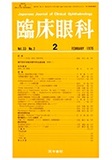Japanese
English
- 有料閲覧
- Abstract 文献概要
緒 言
角膜真菌症は,年々報告例が増加する傾向にあり失明に至る症例も少なくないが,適切な治療法の原則については,ほとんど研究がなされていない。その主な原因は,第1に優れた抗真菌剤がなかつたこと,第2に個々の症例の経過が多種多様であるため治療効果の判定が困難であること,第3に実験に適したシステムがなかつたことなどがある。
しかし最近は優れた抗真菌剤も新たに開発され,また著者は角膜真菌症の研究に適した実験システムを開発した。そこで今回は,これらを用いて各薬剤の最小発育阻止濃度(MIC)と治療効果との関連,ならびに点眼回数・点眼濃度・角膜上皮剥離が治療効果に与える影響について検討した。
I studied the minimum inhibitory concentra-tion (MIC) of econazole, clotrimazole, pimaricin and amphotericin B against Fusarium solani us-ing yeast morphology agar. These antifungal agensts were then topically applied to experi-mentally infected cornea in rabbits. The in vivo curative effect and the MIC value was positively correlated. Econazole nitrate showed noticeable toxicity to the cornea and was judged as clini-cally useless. The frequency of instillation and the concentration of the drug were positively correlated with the therapeutic effect.
Copyright © 1979, Igaku-Shoin Ltd. All rights reserved.


